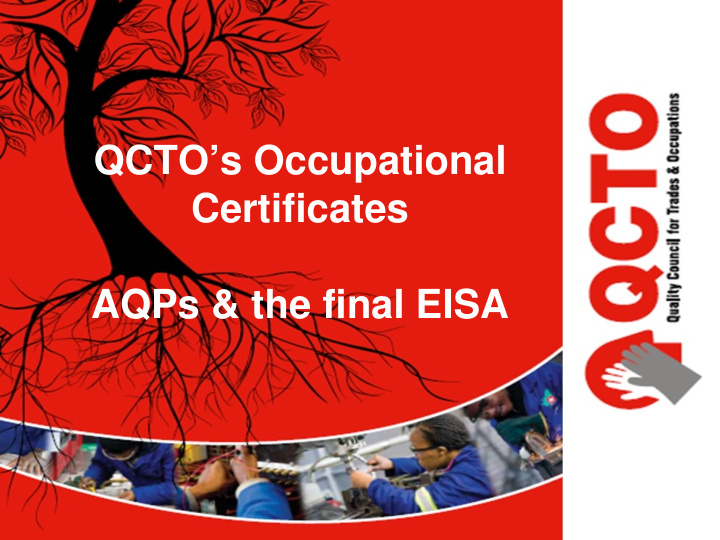



QCTO’s Occupational Certificates AQPs & the final EISA
Who is the QCTO? • The Quality Council for Trades and Occupations (QCTO) is a Quality Council established in 2010 in terms of the Skills Development Act (SDA). • Its role is to oversee the design, implementation, assessment and certification of occupational qualifications on the Occupational Qualifications Sub-Framework (OQSF) • The QCTO is one of three Quality Councils (QCs) responsible for a part of the National Qualifications Framework (NQF) 2
The QCTO’s vision is to “qualify a skilled and capable workforce” QUALIFYING = Become officially recognised as a practitioner of a particular trade or occupation, typically by undertaking training and passing examinations; to provide proper necessary skills, knowledge, credentials, etc.; to make competent to qualify oneself for a job. SKILLED = Having or showing the knowledge, ability or training to perform a certain task/activity well. The ability, coming from one’s knowledge, practice, aptitude, etc. to do something well. CAPABLE = Able to achieve efficiently whatever one has to do; to be competent WORKFORCE = The people engaged or available for work 3
The QCTO is responsible for: • Amongst others, according to Section 26(H)(3) of the Skills Development Act, the QCTO is responsible for: (a) establishing and maintaining occupational standards and qualifications; (b) the quality assurance of occupational standards and qualifications and learning in and for the workplace; (d) ensuring the quality of occupational standards and qualifications and learning in and for the workplace; What are ‘occupational standards’? They specify what a person should know and do in order to effectively carry out the functions of a particular job. 4
Occupational Standards In other words, occupational standards can be regarded as the benchmark of competence required in the relevant sector, which forms the key components of the QCTO’s occupational qualifications. 5
How are these standards implemented? • DQP process – qualification is developed by industry (CEPs) for the industry • Training takes place at SDPs (Skills Development Providers) accredited by the QCTO • The final assessment is conducted and managed by the approved AQP for a particular qualification at an accredited assessment centre • The QCTO therefore sets standards through the model of qualifications, the provisioning as well as the final assessment • The purpose of the EISA is to allow for qualifying learners to become officially recognised as practitioners of a particular trade or occupation with a QCTO certificate 6
The final External Integrated Summative Assessment (EISA) EXTERNAL : An assessment compiled by the AQP is used to assess all learners nationally (those who have qualified for it) INTEGRATED : The EISA not only comprises of an integration of all components and modules: Knowledge, Practical and Workplace, but also of all Exit Level Outcomes SUMMATIVE : The final assessment at the end (similar to ‘Board exams’ / the “Red Seal”) to prove competence ASSESSMENT : The most suitable form of assessment is decided upon to assess the learners’ capability TO DO the job!! 7
Entrance to the EISA Knowledge Workplace Practical Competency in all 3 components is required (and FLC for qualifications at NQF Levels 2 - 4) SoR Learner qualifies for EISA 8
The Assessment Quality Partner’s involvement (AQP) • Each AQP is responsible for the development, organisation and implementation of the final EISA. • The AQP has certain roles and responsibilities with regards to the implementation of the final assessment (EISA). • An AQP may seek (in fact, is encouraged to seek) the technical and subject expertise from the relevant parties/ bodies in industry to ensure that the standards of the final EISA will be met in order to qualify competent learners. • To this end, for the implementation of the qualification, the AQP will ‘project plan’ all activities that will contribute to the success of the EISA, for e.g.: 9
The AQP’s activities: • The activities the AQP is responsible for, are: – The development of the QAS Addendum (set the ‘blueprint’); – Developing a national data-bank of standardised assessment instruments appropriate to the assessment strategy; – Make available a mechanism and process for RPL; – Establish criteria and guidelines for the monitoring and evaluation of accredited assessment centres; – Develop and publish relevant information on their website; – Maintain a candidate record system; – Have a secure system to manage scheduled assessments; – Submit validated learner achievements to the QCTO for certification; – Report qualitatively to the QCTO 10
So – what’s new? • Learners completing the QCTO occupational qualifications will be sitting for a national, external, standardised final assessment in which competency has to be proven, in order to receive the QCTO certificate. • The curriculum document provides assessment criteria for the 3 components (Knowledge / Theory / Workplace) which form part of the formative assessment process, conducted by the SDP • The final EISA is done in an integrated manner on the exit level outcomes of the qualification, and focuses on required competencies for the job • AQPs prescribe the minimum requirements for the assessment specialists to be used for the final EISA 11
By working together, we can all contribute to nation building: 12
THANK YOU Diane Kemp • 012 003 1857 (Diane) Kemp.D@qcto.org.za 13
Recommend
More recommend